Heavy equipment
Heavy equipment or heavy machinery refers to heavy-duty vehicles, specially designed for executing construction tasks, most frequently ones involving earthwork operations or other large construction tasks. Heavy equipment usually comprises five equipment systems: implementation, traction, structure, power train, control and information.[1]
Heavy equipment has been used since at least the 1st century BCE when the ancient Roman engineer Vitruvius described a crane in De architectura when it was powered via human or animal labor.
Heavy equipment functions through the mechanical advantage of a simple machine, the ratio between input force applied and force exerted is multiplied, making tasks which could take hundreds of people and weeks of labor without heavy equipment far less intensive in nature. Some equipment uses hydraulic drives as a primary source of motion.
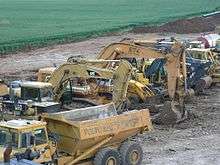
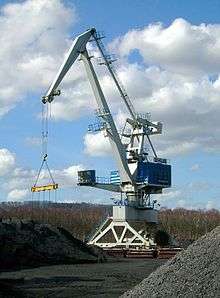


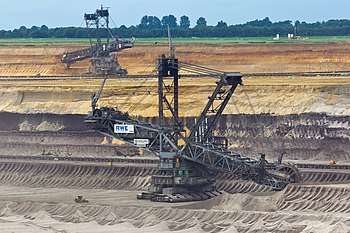
History
- JCB 3CX backhoe loader
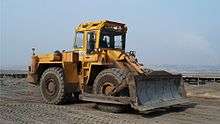 A wheeled bulldozer in an open pit coal mine
A wheeled bulldozer in an open pit coal mine.jpg) A portable engine; a precursor to modern engineering vehicles
A portable engine; a precursor to modern engineering vehicles- An early gasoline-powered tractor
The use of heavy equipment has a long history; the ancient Roman engineer Vitruvius (1st century BCE) gave descriptions of heavy equipment and cranes in ancient Rome in his treatise De architectura. The pile driver was invented around 1500. The first tunnelling shield was patented by Marc Isambard Brunel in 1818.
From horses, through steam and diesel, to electric and robotic
_(14569641579).jpg)
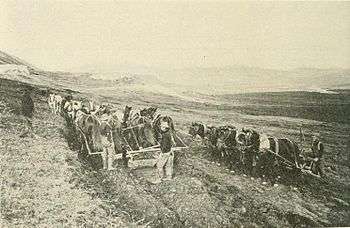
Until the 19th century and into the early 20th century heavy machines were drawn under human or animal power. With the advent of portable steam-powered engines the drawn machine precursors were reconfigured with the new engines, such as the combine harvester. The design of a core tractor evolved around the new steam power source into a new machine core traction engine, that can be configured as the steam tractor and the steamroller. During the 20th century, internal-combustion engines became the major power source of heavy equipment. Kerosene and ethanol engines were used, but today diesel engines are dominant. Mechanical transmission was in many cases replaced by hydraulic machinery. The early 20th century also saw new electric-powered machines such as the forklift. Caterpillar Inc. is a present-day brand from these days, starting out as the Holt Manufacturing Company. The first mass-produced heavy machine was the Fordson tractor in 1917.
The first commercial continuous track vehicle was the 1901 Lombard Steam Log Hauler. The use of tracks became popular for tanks during World War I, and later for civilian machinery like the bulldozer. The largest engineering vehicles and mobile land machines are bucket-wheel excavators, built since the 1920s.
"Until almost the twentieth century, one simple tool constituted the primary earthmoving machine: the hand shovel – moved with animal and human powered, sleds, barges, and wagons. This tool was the principal method by which material was either sidecast or elevated to load a conveyance, usually a wheelbarrow, or a cart or wagon drawn by a draft animal. In antiquity, an equivalent of the hand shovel or hoe and head basket—and masses of men—were used to move earth to build civil works. Builders have long used the inclined plane, levers, and pulleys to place solid building materials, but these labor-saving devices did not lend themselves to earthmoving, which required digging, raising, moving, and placing loose materials. The two elements required for mechanized earthmoving, then as now, were an independent power source and off-road mobility, neither of which could be provided by the technology of that time."[2]
Container cranes were used from the 1950s and onwards, and made containerization possible.
Nowadays such is the importance of this machinery, some transport companies have developed specific equipment to transport heavy construction equipment to and from sites.
Most of the major equipment manufacturers such as Caterpillar,[3] Volvo,[4] Liebherr,[5] and Bobcat have released or have been developing fully or partially electric-powered heavy equipment. Commercially-available models and R&D models were announced in 2019 and 2020.[6]
Robotics and autonomy has been a growing concern for heavy equipment manufacturers with manufacturers beginning research and technology acquisition.[7] A number of companies are currently developing (Caterpillar and Bobcat) or have launched (Built Robotics) commercial solutions to the market.
Types
These subdivisions, in this order, are the standard heavy equipment categorization.
Track-type
- Agricultural tractors
- Bulldozer
- Snowcat
- Track skidder
- Track-type tractors (Bulldozer)
- Tractor
- Military engineering vehicles
Grader
SkidSteer
- Skid steer loader
Excavator
- Amphibious excavator
- Compact excavator
- Dragline excavator
- Dredging
- Bucket-wheel excavator
- Excavator (digger)
- Long reach excavator
- Power shovel
- Reclaimer
- Steam shovel
- Suction excavator
- Walking Excavator
- Trencher (machine)
- Yarder
Backhoe
Timber
- Feller buncher
- Harvester
- Skidder
- Track harvester
- Wheel forwarder
- Wheel skidder
Pipelayer
- Pipelayer (sideboom)
Scraper
Mining
- Construction & mining tractor
- Construction & mining trucks
Articulated
Compactor
Loader
- Loader
- Skip loader (skippy)
- Wheel loader (front loader, integrated tool carrier)
Track loader
- Track loader
Material handler
- Aerial work platform / Lift table
- Cherry picker
- Crane
- Forklift
- Knuckleboom loader (trailer mount) & Knuckleboom loader (trailer mount)
- Straddle carrier
- Reach stacker
- Telescopic handlers
Paving
- Asphalt paver
- Asphalt plant
- Cold planer
- Cure rig
- Paver
- Pavement milling
- Pneumatic tire compactor
- Roller (road roller or roller compactor)
- Slipform paver
- Vibratory compactor, Compactor
Underground
- Roadheader
- Tunnel boring machine
- Underground mining equipment
Hydromatic tool
- Ballast tamper
- Attachments
- Drilling machine
- Pile driver
- Rotary tiller (rototiller, rotovator)
Highway
Images
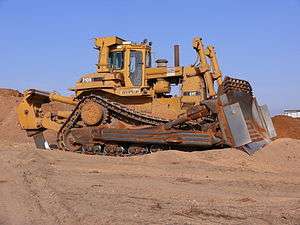 The Caterpillar D10N bulldozer evolved from tracked-type tractors and is characterized by a steel blade attached to the front that is used to push other equipment and construction materials, such as, earth.
The Caterpillar D10N bulldozer evolved from tracked-type tractors and is characterized by a steel blade attached to the front that is used to push other equipment and construction materials, such as, earth.- Normally the bucket is pulled toward the excavator to excavate material. The uncommon "thumb" attachment on this Komatsu PC210-LC enables 'grabbing' objects, for example, during demolition.
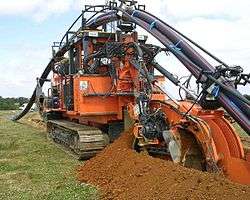 The wheel trencher MARAIS SMC 200 R.
The wheel trencher MARAIS SMC 200 R.
 Wheel loader
Wheel loader.jpg) Grader cleaning and leveling
Grader cleaning and leveling.jpg) Heavy duty excavator with large bucket equipped.
Heavy duty excavator with large bucket equipped.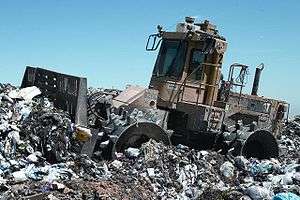 Landfill compactor (tamping tip)
Landfill compactor (tamping tip).jpg) Komatsu Dozer pushing coal on the job site
Komatsu Dozer pushing coal on the job site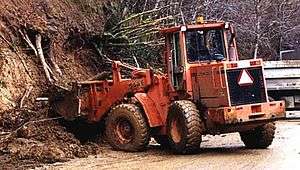 A wheeled front loader tractor equipped with a large bucket elevated by hydraulic rams.
A wheeled front loader tractor equipped with a large bucket elevated by hydraulic rams.- Folded conveyor on a tracked grinder
- Military engineering vehicles
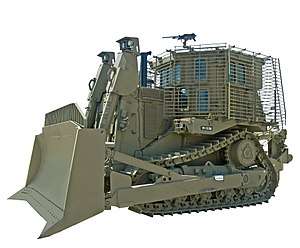 The militarized Caterpillar D9 armored bulldozer allows for earthmoving projects in a combat environment. In the picture: IDF Caterpillar D9R.
The militarized Caterpillar D9 armored bulldozer allows for earthmoving projects in a combat environment. In the picture: IDF Caterpillar D9R.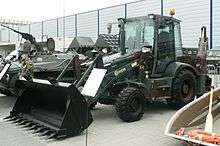
 Military scraper
Military scraper.jpg) PiPz Dachs armoured engineering vehicle of the German Army (2008)
PiPz Dachs armoured engineering vehicle of the German Army (2008)
Implements and hydromechanical work tools
- auger
- backhoe
- bale spear
- broom
- bulldozer blade
- clam shell bucket
- cold plane
- demolition shears
- equipment bucket
- excavator bucket
- forks
- grapple
- hydraulic hammer, hoe ram
- hydraulics
- hydraulic tilting bucket (4-in-1)
- landscape tiller
- material handling arm
- mechanical pulverizer, crusher
- multi processor
- pavement removal bucket
- pile driver
- power take-off (PTO)
- quick coupler
- rake
- ripper
- rotating grab
- sheep's foot compactor
- skeleton bucket
- snow blower
- stump grinder
- stump shear
- thumb
- tiltrotator
- trencher
- vibratory plate compactor
- wheel saw
Traction: Off-the-road tires and tracks
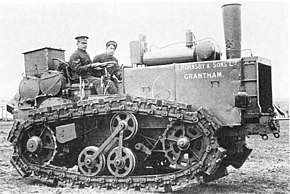
Heavy equipment requires specialized tires for various construction applications. While many types of equipment have continuous tracks applicable to more severe service requirements, tires are used where greater speed or mobility is required. An understanding of what equipment will be used for during the life of the tires is required for proper selection. Tire selection can have a significant impact on production and unit cost. There are three types of off-the-road tires, transport for earthmoving machines, work for slow moving earthmoving machines, and load and carry for transporting as well as digging. Off-highway tires have six categories of service C compactor, E earthmover, G grader, L loader, LS log-skidder and ML mining and logging. Within these service categories are various tread types designed for use on hard-packed surface, soft surface and rock. Tires are a large expense on any construction project, careful consideration should be given to prevent excessive wear or damage.
Powertrain
- internal combustion engine
- transmission
- steering (tracked equipment)
- brakes
Control and information
- "The control and information systems. These systems enable the operator to direct and control all the other systems and provide information to guide operations or to monitor the performance and health of the equipment."[1]
Heavy equipment operator
A heavy equipment operator drives and operates heavy equipment used in engineering and construction projects.[8][9] Typically only skilled workers may operate heavy equipment, and there is specialized training for learning to use heavy equipment.
Much publication about heavy equipment operators focuses on improving safety for such workers. The field of occupational medicine researches and makes recommendations about safety for these and other workers in safety-sensitive positions.
Equipment cost
Due to the small profit margins on construction projects it is important to maintain accurate records concerning equipment utilization, repairs and maintenance. The two main categories of equipment costs are ownership cost and operating cost.[10]
Ownership cost
To classify as an ownership cost an expense must have been incurred regardless of if the equipment is used or not. These costs are as follows:
- purchase expense
- salvage value
- tax savings from depreciation
- major repairs and overhauls
- property taxes
- insurance
- storage
Depreciation can be calculated several ways, the simplest is the straight-line method. The annual depreciation is constant, reducing the equipment value annually. The following are simple equations paraphrased from the Peurifoy & Schexnayder text:
|
m = some year in the future N = equipment useful life (years) and Dn = Annual depreciation amount
Book value (BV) in year m
|
example: N = 5 purchase price = $350,000 m = 3 years from now
|
Operating cost
For an expense to be classified as an operating cost, it must be incurred through use of the equipment. These costs are as follows:[11]
|
|
|
The biggest distinction from a cost standpoint is if a repair is classified as a major repair or a minor repair. A major repair can change the depreciable equipment value due to an extension in service life, while a minor repair is normal maintenance. How a firm chooses to cost major and minor repairs vary from firm to firm depending on the costing strategies being used. Some firms will charge only major repairs to the equipment while minor repairs are costed to a project. Another common costing strategy is to cost all repairs to the equipment and only frequently replaced wear items are excluded from the equipment cost. Many firms keep their costing structure closely guarded as it can impact the bidding strategies of their competition. In a company with multiple semi-independent divisions, the equipment department often wants to classify all repairs as "minor" and charge the work to a job – therefore improving their 'profit' from the equipment.
Models
Die-cast metal promotional scale models of heavy equipment are often produced for each vehicle to give to prospective customers. These are typically in 1:50 scale. The popular manufacturers of these models are Conrad and NZG in Germany, even for US vehicles.
Notable manufacturers
The largest 10 construction equipment manufacturers in 2015 based on revenue data of top 50 manufacturers published by KHL Group [12]
| No. | Company | Country | CE Sales (million USD) | Share of total |
|---|---|---|---|---|
| 1 | Caterpillar | 28,283 | 17.8% | |
| 2 | Komatsu | 16,877 | 10.6% | |
| 3 | Hitachi Construction Machinery | 7,790 | 4.9% | |
| 4 | Volvo Construction Equipment | 7,785 | 4.9% | |
| 5 | Terex | 7,390 | 4.6% | |
| 6 | Liebherr | 7,129 | 4.5% | |
| 7 | John Deere | 6,581 | 4.1% | |
| 8 | XCMG | 6,151 | 3.9% | |
| 9 | Sany | 5,424 | 3.4% | |
| 10 | Doosan Infracore | 5,414 | 3.4% |
Other manufacturers include:
- Atlas Copco
- Bharat Earth Movers Limited (India)
- Bobcat Company
- CASE
- Chelyabinsk Tractor Plant
- CNH Global
- Demag
- Fiat-Allis
- HIAB
- Hyundai Heavy Industries
- Ingersoll Rand
- JCB
- Kubota
- Kobelco
- LiuGong
- MARAIS
- Navistar International Corporation
- NCK
- New Holland
- Track Marshall
- Orenstein and Koppel GmbH (O&K)
- Paccar
- Poclain
- Rototilt
- Shantui
- ST Kinetics
- Takeuchi Manufacturing
- Wacker Neuson
- Yanmar
- Zoomlion
| Wikimedia Commons has media related to Construction vehicles. |
See also
| Wikimedia Commons has media related to Construction equipment. |
- Construction equipment theft
- Non-road engine
- Associated Equipment Distributors, the trade association for heavy equipment distributors
References
- C. B. Tatum et al., J. Constr. Engrg. and Mgmt. 132, 987 (2006)
- Haycraft, William R. (2011). "History of Construction Equipment". Journal of Construction Engineering and Management. 137 (10): 720–723. doi:10.1061/(ASCE)CO.1943-7862.0000374.
- Lambert, Fred (January 29, 2019). "Caterpillar unveils an all-electric 26-ton excavator with a giant 300 kWh battery pack". Electrek. Wright’s Media. Retrieved July 14, 2020.
- McLoud, Don (April 24, 2020). "Volvo CE gets $2M grant to test electric excavator, loader in California". Equipment World. Randall-Reilly. Retrieved July 14, 2020.
- Gruver Doyle, Marcia (November 18, 2019). "Liebherr's prototype battery-powered LB 16 drilling rig has 10-hour run time (VIDEO)". Equipment World. Randall-Reilly. Retrieved July 14, 2020.
- Rubenstone, Jeff (June 5, 2019). "Construction Equipment Goes Electric, But Hurdles Remain". Engineering News-Record. BNP Media. Retrieved July 14, 2020.
- "Caterpillar Announces Acquisition of Robotic Expertise". Caterpillar. June 2020. Retrieved July 14, 2020.
- U.S. Department of Labor – Occupational Outlook Handbook
- V. J. Davies, Ken Tomasin (1996). Construction Safety Handbook. Thomas Telford. ISBN 0-7277-2519-X.
- Peurifoy & Schexnayder "Construction Planning Equipment, and Methods" McGraw Hill 6th edition ISBN 0-07-232176-8, 2002.
- Bartholomew, S.H. "Estimating and Bidding for Heavy Construction" CSU Chico, Upper Saddle River, NJ: Prentice Hall, ISBN 0-13-598327-4, 2000
- ""Equipment Top 50 (2015 Yellow Table)". International Construction April 2015: page 14".